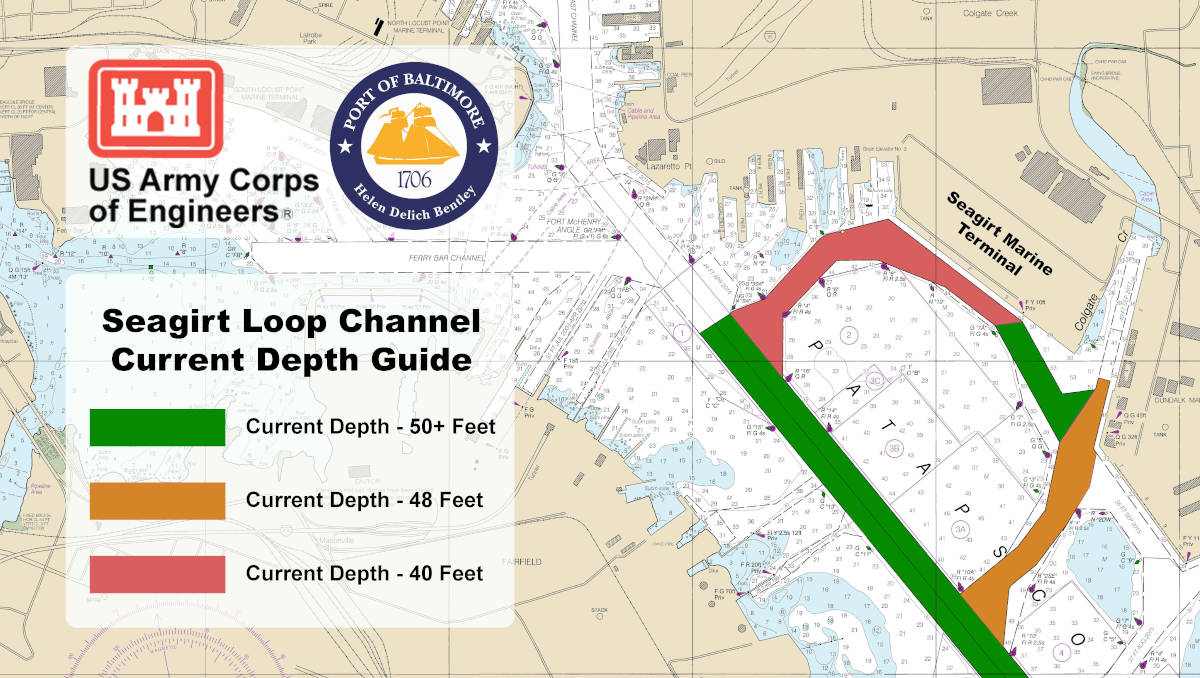Army Corps, MDOT MPA initiate study to improve channel for container ships calling at Seagirt
Oct 08, 2020The U.S. Army Corps of Engineers (USACE), Baltimore District, and the Maryland Department of Transportation Maryland Port Administration (MDOT MPA) are launching a study to determine ways to address marine navigation at the Seagirt Loop channel in Baltimore Harbor, with goals of improving capacity, safety and efficiency at the Seagirt Marine Terminal within the Port of Baltimore.
“The Port of Baltimore is a major economic generator for our state, and we continue to plan for its bright future," said Governor Larry Hogan. "With the partnership of the Army Corps of Engineers, we are making improvements at the Seagirt Marine Terminal that will positively impact Maryland's economy and our job growth for years to come."

The agreement between USACE and MDOT MPA formally begins a study of improvements to the Seagirt Loop channel leading in and out of Seagirt Marine Terminal. Under a Feasibility Cost-Sharing Agreement, the two partners will evenly split the cost of the estimated $3 million study.
“The Port of Baltimore is important to the national economy, and the U.S. Army Corps of Engineers is committed to working with our partners at the Maryland Port Administration to ensure that continues,” said USACE Baltimore District Commander Col. John Litz. “This study will investigate how to safely and efficiently accommodate the growing number of larger container ships for years to come.”
The channels in Baltimore Harbor that form the Seagirt Loop are authorized and maintained to depths varying from 42 to 51 feet. With these varying channel conditions, the study is needed to examine navigation efficiencies and transportation cost savings that could be gained improving the Seagirt Loop channel to better accommodate the larger vessels that call at the Port of Baltimore. The study will consider channel modifications including deepening, widening and modifying channel bends.
“This is an important study that can help us improve the regional supply chain and provide a lasting benefit to Maryland’s economy and job growth,” said MDOT Transportation Secretary Greg Slater. “The Army Corps of Engineers is a terrific partner for MDOT MPA on this project because we share a commitment to safety and the Port of Baltimore’s future success.”
Seagirt Loop is made up of the Seagirt West Branch Channel that tracks along the Seagirt Marine Terminal, and portions of Dundalk/Seagirt Connecting Channel and West Dundalk Branch Channel. It connects to Fort McHenry Channel used by ships entering and exiting the harbor.
“We value our partnership with the U.S. Army Corps of Engineers and we are very excited to move forward with them on developing the Seagirt loop channel to accommodate today’s ultra-Panamax container ships,” said MDOT MPA Executive Director William P. Doyle. “As our container volumes continue to grow and we expand the Seagirt Marine Terminal, a wider, deeper loop channel that’s safely navigable for vessels is critical.”
With its existing 50-foot deep channel and Neo-Panamax cranes, the Port of Baltimore is already able to accommodate some of the largest container ships in the world, and has experienced significant growth in containers in recent years. In 2019, a record 657,059 containers were handled at the public marine terminals, and the Port also handled a record 1,073,749 Twenty-foot Equivalent Units (TEUs).
Last month, as the state continued its economic recovery from the impact of COVID-19, longshore workers at the Port of Baltimore conducted 5,536 container moves while handling the Maersk Edinburgh. It was the largest number of moves for a single ship in the Port’s 314-year history.
The Port’s existing 50-foot berth and supersized cranes are results of the public-private partnership (P3) between MDOT MPA and Ports America Chesapeake. The 50-year agreement, signed in 2009 in the wake of a national recession, generated thousands of jobs and continues to result in increased tax revenue for the state and funds for the Transportation Trust Fund.
As part of the P3, work is progressing on deepening a second 50-foot berth that will allow two massive ships to visit the Port at the same time. That berth, and four new supersized cranes, are expected to be operational by summer 2021.
The Port’s growing container business also accentuates the importance of the Howard Street Tunnel expansion project in Baltimore, which will accommodate the use of double-stacked rail cars to move cargo from the Port. That project is benefitting from another public-private investment from the state, CSX and others.
Similar Stories

NRF praises tentative labor deal for East Coast, Gulf Coast ports
View Article
Hyster to provide electric empty container handler at Malta Freeport Terminals
View Article
Consolidated Chassis Management expands leadership team with four key hires
View Article
APM Terminals Maasvlakte II signs cooperation contract with Embotech and Terberg for the purchase of 30 electric automated terminal trucks
View ArticleGreat Lakes announces election of new director
Great Lakes Dredge & Dock Corporation ("Great Lakes" or the “Company”), the largest provider of dredging services in the United States, announced that Dana Armstrong was elected to its Board…
View Article
CBP officers seize counterfeit Tiffany & Co. jewelry
View ArticleGet the most up-to-date trending news!
SubscribeIndustry updates and weekly newsletter direct to your inbox!





